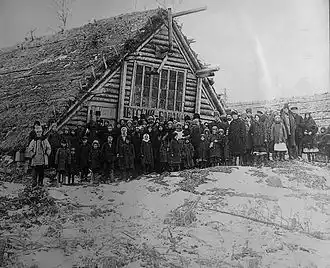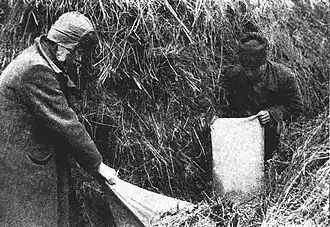Kulaks were prosperous peasants whose farm with a large amount of land was run with the help of paid laborers. The term, which is kurkul in Ukrainian, also was used to identify peasants who were against the Soviet-run government. [1]Kulaks were labeled as 'reactionaries' and 'counter-revolutionaries' by Stalin and his apparatchiks. [2] The criterion of peasants who were labeled as kulaks also was as simple as a peasant who had “an extra cow or an extra bedroom.” Accusations from neighbors who were jealous of another peasant were sometimes enough for people to be identified as kulaks. [3]

Peasants were able to become more prosperous due to the opportunities that came with the Stolypin Agrarian Reforms in 1906. These reforms allowed for more prosperous peasants to leave their village communes and buy no more than five parcels of land. Kulaks had the ability to lease their land and purchase farming equipment, in addition to employing laborers. This system for running their farms mirrored the ways of farming with capitalist values. [1]
Research your ancestors on MyHeritage
Persecution of kulaksPersecution of kulaks
Vladimir Lenin, USSR leader, demeaned the kulaks in his speeches and encourage hatred for them. “A wave of kulak revolts is sweeping across Russia. The kulak hates the Soviet government like poison and is prepared to strangle and massacre hundreds of thousands of workers...The workers must crush the revolts of the kulaks with an iron hand.” The kulaks were accused of hiding their supplies of food, with the intention to starve the working class. [4]
About 2 million kulaks were removed from their farms and relocated to the Far North of the USSR and Siberia. [5] It is estimated that almost 75,000 families identified as kulaks were removed from their Ukrainian villages and relocated to isolated areas of Kazakhstan and Siberia in 1930. [6] Some died while being transported to their new forced locations, shortly afterwards or within a few years of living at the new locations. [1] Removing of the kulaks from villages was done after the Politburo of the Central Committee of the Communist Party ordered on Jan. 30, 1930 a resolution to liquidate kulak property, an act that became to be known as dekulakization. [7]
The persecution of the kulaks was done for two reasons: to eliminate the people who were promoting opposition to collectivizing farms and to provide a strong warning that it is better to join the collective farms than to experience the same punishment of the kulaks. [8] The intentional removal of kulaks is believed to have led to the Ukrainian famine that starved to death between 3 million and 5 million people from 1932-1933. [5] With less people to farm the land, Ukraine couldn't produce enough food to feed its people.
The forced removal and relocation of kulaks ended when Joseph Stalin and Viacheslav Molotov, chairman of the Council of People's Commissars of the Soviet Union, secretly ordered on May 8, 1933 terminating the activities but the order allowed another 2,000 Ukrainian kulaks to be removed and relocated. [1]
Life for kulaks in exileLife for kulaks in exile
Kulaks served as forced laborers at the camps where they were sent for relocation. They were assigned to live in certain settlements and workplaces. So many kulaks arrived at their new locations that insufficient housing was available to them. Some barracks had three or four families crammed into one room. The same supply issue existed with food, clothing and winter boots for the kulaks. [3]

Most of the kulaks were required to work on collective farms in their locations of the sub-Arctic Russia, western Siberia, Kazakhstan and the northern area of the Ural Mountains. Others were required to work in dangerous conditions at mines. The circumstances were so harsh that many kulaks died from hunger or disease or due to the inability to survive in the extreme cold. [1] By 1941, 930,000 kulaks were living in 1,750 settlements. More kulaks were working in industry (50 percent) while the rest was equally split for working in agriculture and forestry. Meanwhile, the kulaks' children attended schools within the settlements. [9]
The time it took to allow the persecuted kulaks to leave their settlements was long. By spring 1930, about 10 percent of kulaks were “rehabilitated” and allowed to leave for their homeland. [1] Then in 1938, children of kulaks who were at least 16 years old were granted the right to leave their settlements to work, pursue higher education or receive technical training. The USSR needed more soldiers during WWII. By November 1942, more than 60,000 kulaks were serving for the Soviet army. Many kulaks were permitted after World War II to return home. (6) The number of kulaks living in their settlements dwindled to about 24,000 in 1951. [9]
Researching kulaksResearching kulaks
Finding information on relatives and ancestors who were persecuted as kulaks is becoming easier as time goes on. The State Archive Service of Ukraine introduced the Ukrainian Martyrologist of the 20th Century Database in 2020 to release information on the persecution victims from the 1920s to 1950s. The database has information such as birth year, birthplace, profession, names of relatives and arrest details on more than 130,000 victims that included kulaks. Expanding the database is a continuing process.

Before the Ukrainian Martyrologist of the 20th Century Database was introduced, the National Bank of the Repressed was made available on persecution victims from Ukraine. The list of more than 370,000 victims is available to view in alphabetical order or can be searched by name, birthplace and last place of residence.
But the largest database for victims of Soviet-era persecution is offered by now-defunct organization Memorial of Moscow, Russia. The searchable database of more than 3 million people will never be updated because Russia's supreme court ordered Memorial to be liquidated four days after Russia invaded Ukraine in 2022. Memorial was accused of being a foreign agent after spending 23 years educating the public about the atrocities that occurred during the former USSR's era. [10]
Explore more about kulaksExplore more about kulaks
- Russians Immigrating to the United States at MyHeritage
- Russia, Cemetery Records at MyHeritage This database is a free resource.
- Beginning Ukrainian Genealogy at Legacy Family Tree Webinars
See alsoSee also
References
- ↑ 1.0 1.1 1.2 1.3 1.4 1.5 Kulak. Internet Encyclopedia of Ukraine
- ↑ “Russia: A Journey to the Heart of a Land and its People,” Jonathan Dimbleby, BBC Books, 2008.
- ↑ 3.0 3.1 “Gulag: A History,” Anne Applebaum, Anchor Books, 2003.
- ↑ “Russia: A 1,000 Year Chronicle of the Wild East,” Martin Sixsmith, Overlook, 2011.
- ↑ 5.0 5.1 Stalin killed millions. A Stanford historian answers the question, was it genocide? StanfordReport, Sept. 23, 2010
- ↑ “The Gates of Europe: A History of Ukraine,” Serhii Plokhy, Basic Books, 2015.
- ↑ Dekulakization. How Stalin liquidated the Ukrainian peasant class (Part 4) Euromaidan Press, Aug. 11, 2011,
- ↑ The War against the 'Kulaks'. Orlando Figes, 2014
- ↑ 9.0 9.1 “The Unknown Gulag: The Lost World of Stalin's Special Settlements,” Lynne Viola, Oxford University Press, 2007.
- ↑ Russia’s Supreme Court approves liquidation of International Memorial. Memorial. Feb. 28, 2022

